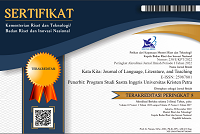MOTIVATIONAL STRATEGIES USED BY AN ENGLSH TEACHER AT HAND FORTUNA CENTER
DOI:
https://doi.org/10.9744/katakita.5.1.100-106Keywords:
Attitude Towards Using Mobile Payment, Continue Use Intention, Perceived Security, Perceived Usefulness, Social InfluenceAbstract
This is a qualitative study on the use of motivational strategies by the English teacher at Hand Fortuna Center. This study was based on Dörnyei’s (2001) theory about motivational strategies and focused on the interaction between the teacher and his students in the classroom. The data were collected by using video recording and interview. The observation was done in three meetings within two weeks. The duration of the class was 90 minutes for each meeting. The findings showed that the teacher used five out of eight motivational strategies in the classroom. There were making learning stimulating and enjoyable, protecting the learners’ self-esteem and increase their self-confidence, presenting task in a motivating way, allowing learners to maintain a positive social image, and promoting cooperation among the learners. For the interview, the writer found that the reason why the teacher used the motivational strategies. It was because the strategies could increase students’ motivation in learning language.References
Brophy, J. (2004). Motivating Students to Learn (2nd ed.). London: Lawrence Erlbaum Associates.
Cheng, H. and Dörnyei, Z. (2007). The Use of Motivational Strategies in Language Instruction: The Case of EFL Teaching in Taiwan. Retrieved April 27th, 2016 from http://www.zoltandornyei.co.uk/uploads/2007-cheng-dornyei-illt.pdf
Dörnyei, Z. (2001). Motivational Strategies in the Language Classroom. New York: Cambridge University Press.
Dörnyei, Z. (2007). Research Methods in Applied Linguistics: Quantitative, Qualitativ, and Mixed Methodologies. Oxford: University Press.
Lightbown, M. P. and Spada, N. (2006). How Languages are Learnerd (3rd ed.). Oxford: Oxford University Press
Long, C., Ming, Z., & Chen, L. (2013). The Study of Student Motivation on English Learning in Junior Middle School -- A Case Study of No.5 Middle School in Gejiu. Journal of English Language Teaching. 6(9), 136-145 Retrieved from http://dx.doi.org/10.5539/elt.v6n9p136
Marzano, J. R., Pickering, J. D., & Heflebower, T. (2010). The Highly Engaged Classroom. Retrieved December 16th, 2016 from http://www.centergrove.k12.in.us/cms/lib4/IN01000850/Centricity/Domain/1217/The%20Main%20Idea%20-%20The%20Highly%20Engaged%20Classroom.Pdf
Palmer, D. (2005). A Motivational View of Constructivist-informed Teaching. International Journal of Science Education, 27(15), 1853-1881.
Orio, S.F. (2013). Motivation and Second Language Acquisition. Retrieved December 16th, 2016 from http://biblioteca.unirioja.es/tfe_e/TFE000342.pdf
Rudhumbu, N. (2014). Motivational Strategies in the Teaching of Primary School Mathematics in Zimbabwe. International Journal Education and Development UK, 2(2), 76-103.
Yousevin. (2015). Motivational Strategies Applied in the First Grade of Primary School. Retrieved from Digital Collection Petra Christian University
Downloads
Issue
Section
License
Authors who publish with this journal agree to the following terms:- Authors retain copyright and grant the journal right of first publication with the work simultaneously licensed under a Creative Commons Attribution License that allows others to share the work with an acknowledgement of the work's authorship and initial publication in this journal.
- Authors are able to enter into separate, additional contractual arrangements for the non-exclusive distribution of the journal's published version of the work (e.g., post it to an institutional repository or publish it in a book), with an acknowledgement of its initial publication in this journal.
- Authors are permitted and encouraged to post their work online (e.g., in institutional repositories or on their website) prior to and during the submission process, as it can lead to productive exchanges, as well as earlier and greater citation of published work (See The Effect of Open Access).














